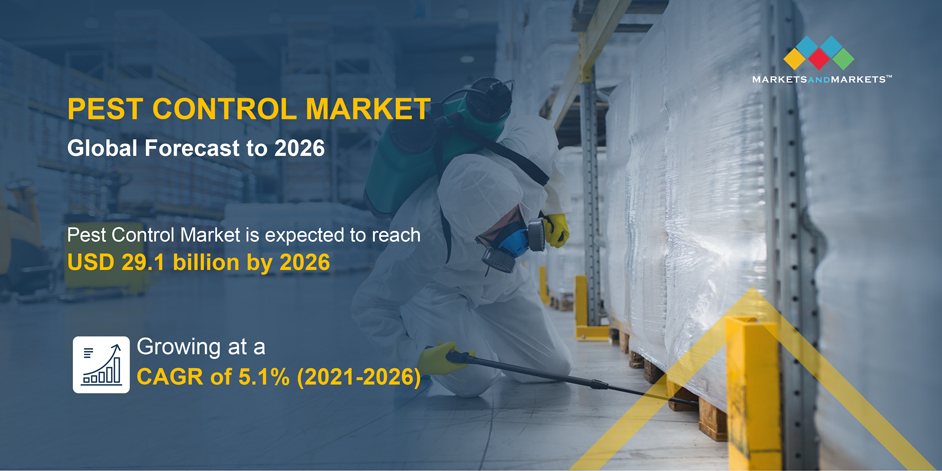The globalpest control marketis projected to reach USD 29.1 billion by 2026, at a compound annual growth rate (CAGR) of 5.1% during the forecast period. It is estimated to be valued USD 22.7 billion in 2021. The pest control market is expected to experience significant growth opportunities due to the increasing demand for pest control services, growing awareness about environmental concerns, advancements in technology, government regulations, and the increasing prevalence of pest-borne diseases. Companies that can offer innovative, eco-friendly, and sustainable pest control solutions that can meet regulatory requirements and include disease prevention are likely to see growth in the market.

Download PDF Brochure:https://www.marketsandmarkets.com/pdfdownloadNew.asp?id=144665518
Drivers: Rising adoption of digital applications and technology
Pest control is a prime aspect of food safety across the global food supply chain. Automation and sustainable approach have gained prominence within the supply chain. The number of service providers in the pest control market has witnessed a significant increase in recent years, driven by consumer demand for pest control services. Pest control service providers have extended their available services from control, extermination, and prevention to monitoring and suppression, with the help of digital technologies and traps, including motion sensors and automated traps.
Companies such as Rentokil Initial PLC provide digital pest control systems such as PestConnect range of IoT-enabled pest-control devices that allows the monitoring of food processing facilities with maximum efficiency and minimum effort. CRE8TEC Pte. Ltd., based in Singapore, Thailand, Indonesia, and Sri Lanka, developed RATSENSE, an integrated infrared sensor-based system backed by data analytics for pest control.
Opportunities: Adoption of Artificial Intelligence (AI) in pest control
Artificial intelligence (AI) implementation in pest control has been rising because of the low service cost and its operation in remote, along with difficult-to-access locations continuously without interrupting the operations of the facility. The demand for digital pest control solutions is rising because service-provider companies use AI-based image-recognition technology to identify and treat various bugs and vermin.
App-based bug identification helps quick identification and effective remediation solutions for efficiently implementing proper treatment plans, including proper chemicals and recommendations for homeowners. Convenience and time-saving are the two prime advantages provided by the incorporation of AI in pest control. The use of machine learning software assists in identification process optimization.
Request Sample Pages:
https://www.marketsandmarkets.com/requestsampleNew.asp?id=144665518
North America is estimated to dominate the global pest control market over the forecast period.
According to reports by major service providers, Rentokil Initial Plc (UK) and Anticimex (Sweden), North America occupies nearly 50% of the global pest control market. This is attributed to the increase in the number of services available in the US and a high rate of urbanization in the US and Canada. The strengthening of the housing market and a steadily improving economy have led to increased investments in both residential and commercial properties. These factors are driving the market in the region.
The key players in this market include Bayer AG, Corteva Agriscience, BASF, Sumitomo Chemical Co., FMC Corporation, Syngenta AG, ADAMA, and Bell Laboratories. These players in this market are focusing on increasing their presence through agreements and collaborations. These companies have a strong presence in North America, Asia Pacific and Europe. They also have manufacturing facilities along with strong distribution networks across these regions.















